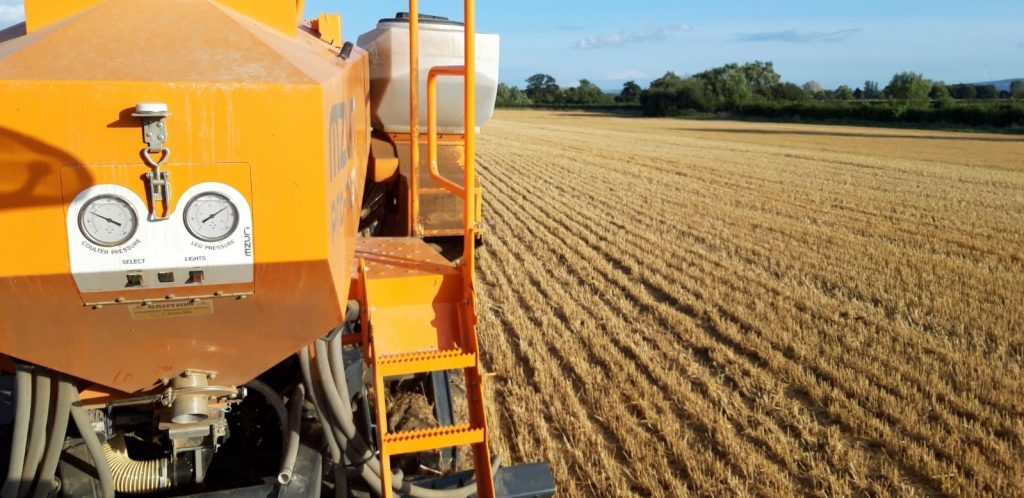Spring Wheat
The month began with the combine rolling once more with a return into wheat, this time spring sown. Showing promise from the beginning I was pleased to be harvesting and finally finding out what the weighbridge had to say! We weren’t disappointed with the steady stream of trailers required for over 20 hectares averaging 8.7t/ha. Initial impressions of the samples off the trailers was good, with a bright grain with a consistent specific weight of 79kg/hl.
The variety KWS Cochise is a Group 2 milling wheat, however, we chose it for its strong agronomic and yield merits. Call me an optimist, but despite having grown the crop as a feed wheat as with the rest of the farm, I cleared a bay to keep it separate until a had the test results back from the merchants. I’m relieved I did, with the crop achieving milling specification, with proteins averaging 12.9% and the Hagberg holding up. A fantastic result, both in terms of outright yield, with the icing on the cake of a milling premium on top of the anticipated feed price!
This was followed by a quick turnaround with the Mzuri Pro-Til being put to work sowing a cover crop comprising of oats, phacelia, vetch and sunflower. Maize was also added to the mix as a trial for an area, which although rather a late sowing with the ground being warm it’ll be interesting to see how much biomass above and below ground it delivers before winter sets in. The cover crop was sown into chopped straw which still had a slight green tinge about it, as is our usual practice it was drilled at 30 degrees to the tramline/ combine, with residue flowing with ease through the drill. Final reconsolidation came from the coulter press wheel, meaning no follow up roll was required, achieving a low cost and consistent establishment of a very important crop to our rotation.
Winter Oilseed Rape
The odd behaviour to anyone unfamiliar with growing OSR made a return to Springfield Farm at the beginning of the month with me crawling around wheat stubbles looking for evidence of slugs and of course the dreaded flea beetle (CSFB). The dry conditions were ideal for CSFB, and sure enough they arrived at the crop after a week’s reprieve post emergence.
With an eye to our 2020 OSR crop we took part in a research project undertaken by Rothamsted Research PhD student Caitlin Willis, looking at CSFB resistance to pyrethroids. This involved gathering 100 CSFB in our grain store during July to be sent off for testing. The Midlands region unsurprisingly, given the CSFB pressure seen last autumn and subsequently in the spring, provided a glut of samples and unfortunately ours didn’t end up being tested. However, the results obtained made for stark reading, with resistance averaging 75% in the region (see map). With this is mind anything more than a single spray is unlikely to prove effective.
Following a strong performance last season, DK Expedient is our main variety being grown at Springfield this year. The hybrid seed cost of £78/ha (50 seeds/m2), is approximately double that of KWS Campus (70 seeds/m2) the conventional variety we have used on the farm for several years. The additional expense I feel is justified for the outstanding vigour it displays, even when compared to Campus, a variety known for its get up and go. As seen last year, the first true leaf of Expedient was emerging after only a week. With the diminishing effectiveness of pyrethroids and the detrimental impact on our beneficial insects from their use, swift establishment is the critical factor to survive CSFB damage.
Conditions following sowing as is frequently the case with WOSR, turned decidedly dry and windy. The moisture preserved at sowing once again being so critical to aid strong, even establishment -With only increasingly Autumnal dews to providing young plants light relief from above. Shot holing soon became evident and an after dark check of the crop by torchlight illuminated at least one CSFB per plant meaning an insecticide was called for. The following evening the sprayer was fired up and set to work. I was quickly reminded of a job that was put on the to do list this time last year, which was to upgrade the tractor work lights to LED. Luckily though with no in field trees or telegraph poles in the OSR fields, I was reasonably unlikely to run into trouble!
We finally received 7mm of rain on the 10th Sept, which was as helpful to the crop as an insecticide. With the wind in a North and Easterly pattern, we did see a further migration of CSFB on the 13th, but by this point the crop had grown past the vulnerable stage.
With the dry conditions seen at the beginning of the month wheat volunteers were slow to germinate. This saw Centurion Max not being applied until the 19th at 1.0l/ha, in all but ideal conditions. Uptake of the graminicide was quick, as soils remained warm supporting active growth, with the familiar yellowing of leaves seen by the end of the month – a good result all round.

The Spring Wheat went through to combine at the beginning of September

Closely followed by the Pro-Til and the cover crop seed!

Inter row drilled Oilseed Rape